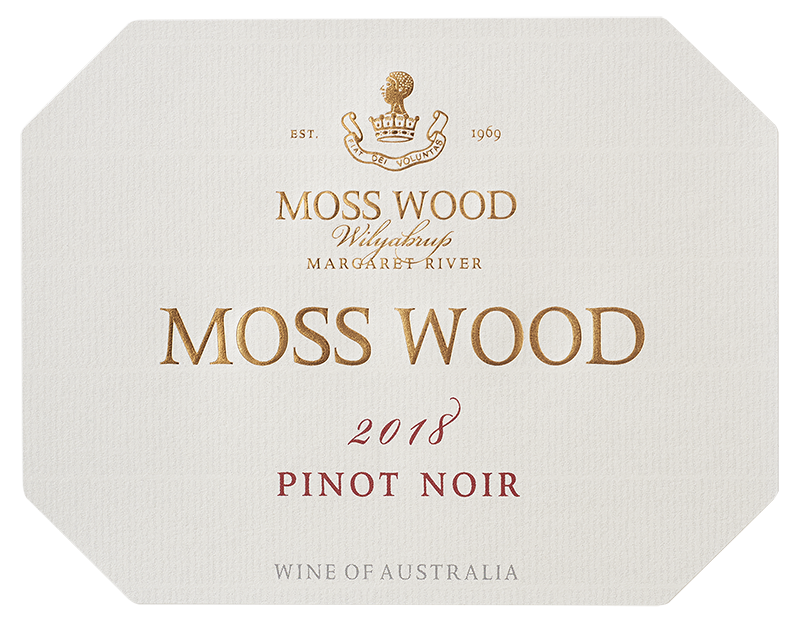Moss Wood 2018 Pinot Noir

| Wine Facts | |
|---|---|
| Median Harvest Date | 28th February, 2018 |
| Mean Harvest Ripeness | 13.8 °Be |
| Yield | 8.73 t/ha |
| Weather Data | Growing Season Ave Temperature – 19.25⁰C Number of hours accrued between 18 and 28⁰C – 1114 Number of hours above 33⁰C – 12 |
| Days Elapsed between Flowering and Harvest | 110 days |
| Bottled | 31st October, 2019 |
| Released | 1st September, 2020 |
| Alcohol | 14% |
Wine Facts
-
Median Harvest Date
28th February, 2018
-
Harvest Ripeness
13.8 °Be
-
Yield
8.73 t/ha
-
Weather Data
Growing Season Ave Temperature – 19.25⁰C
Number of hours accrued between 18 and 28⁰C – 1114
Number of hours above 33⁰C – 12 -
Days Elapsed between Flowering and Harvest
110 days
-
Bottled
31st October, 2019
-
Released
1st September, 2020
-
Alcohol
14%
Vintage Notes
After reporting the complications of the 2019 Chardonnay season, we now attempt to repair the reputation of Margaret River’s spring and what better way than with the 2018 Pinot Noir. It’s the first of our red wine releases from this vintage and we have high hopes for all and believe they will rival any of the great years from the past.
Having had such a late, cool season in 2017, it was good to enjoy conditions closer to our long-term average for the 2018. Looking back at them now, things seem almost boring by comparison but that’s OK because at Moss Wood we would take boring over challenging every year, if we had the choice.
For the record, Pinot Noir’s median flowering date is 9th November and for the 2018 it was 11th November. Weather conditions through this period were benign, with rain on only 5 of the 31 days and the temperature dropped below 8°C for only 4 nights. No surprise then that yields were up 39% to 8.73 tonnes per hectare. That is a rare treat!
People who visited Margaret River over the summer of 17/18 will recall a succession of days in the mid-20’s, just warm enough for the beach and perfect for grape ripening. Pinot Noir reveled in these conditions, ripening steadily over 110 days from flowering to harvest, using
up 1114 hours between 18° and 28°C, coming off at 13.8° Baume on 28th February. Sadly for beach-going sun worshippers, but happily for grapegrowers, there were only 12 hours when the temperature exceeded 33°C. Full ripeness was higher and later than the long-term average of 13.4° Baume and 23rd February, respectively and not surprising, given the heavier crop.
There was no bird damage and the fruit was in perfect condition when it was hand-picked and delivered to the winery.
Production Notes
The handling process was classical Moss Wood Pinot Noir. Approximately 92% of the fruit was sorted and destemmed into small open tanks and then the remaining 8% was added back as whole bunches. The must was then chilled and held at 5°C for 48 hours and was then allowed to warm before being seeded with multiple yeast strains for primary fermentation. Each batch was hand plunged 3 times per day and temperatures were controlled to a maximum of 32°C. After 15 days on skin, each batch was pressed to stainless steel and underwent malolactic fermentation. Once that was completed, each batch was adjusted for acidity and SO2 and racked to wood. All barrels were 228 litre French oak and 15% were new.
In October 2019, after 19 months in barrel, each batch was racked and blended in stainless steel. The fining trials were then carried out but none improved the wine, so it was then sterile filtered and bottled 31st October, 2019.
What was difficult about that, you may ask? And you’d be right. You see, we can (and do) enjoy easy years in Margaret River.
Tasting Notes
Colour and condition:
Medium ruby hue; bright condition.
Nose:
Lots of pretty fragrances – black fruit notes like sour cherries, plus strawberry jam, musk, camphor and roses. Complexity comes from mushroom and earthy notes, almost charcuterie and there is a nice toasty oak background.
Palate:
This is medium to full bodied, with bright and generous strawberry and cherry fruit flavours, with rose water and mushroom notes on the finish. The acidity gives good lift and the tannins are a subtle but firm presence, adding concentration and length. On the finish there is a touch of toasty oak.
Cellaring
This vintage is right amongst our best and so we have high expectations for cellaring. The bright and generous fruit characters make it extremely consumable as a youngster but for those with patience and room in their cellar it will reward long term ageing. It will need at least 10 years to develop the bottle-derived secondary notes of mushrooms and earth and these will gradually dominate the wine over the next decade or so. We expect full maturity at 25 years of age.
